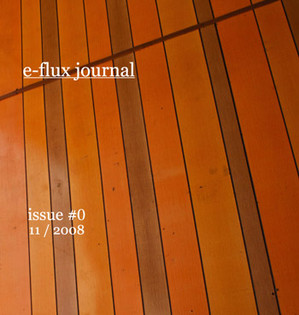This is an archive of the ArtCat Zine, 2007-2009. Please visit our new project, IDIOM.
E-flux Journal Launch
In The Invention of Public Weather, writer Bilal Khbeiz describes Los Angeles as a place beyond history, a place where history is only ever rehearsed and depicted. In the short text, the city is described as a deeply produced environment, a kind of amnesiac oasis for a people as afraid of the empty desert all around as of a quickly vanishing public sphere. While divisions between ethnic enclaves prescribe the discreet local conditions for everyday life, a grid of expansive private spaces is further expanded by a dense network of roads and its accompanying automobile culture. Would it be so hard to imagine the Internet as such a place? Identifiable in many of the world's countries is a small suite of popular online super brands that drive tremendous network traffic. Since the popularization of the Web 2.0 style of interface and information design, these proprietary online services peddle primarily in new modes of mediated user interaction while, in a sense, eclipsing content. Hence the super brands of today are sites that only structure access to media, often indifferent to the content those structures deliver. What constitutes public and private space on the Internet, of course, is a complex question. The Internet is neither Khbeiz's Los Angeles nor anybody else's. But why not consider the digital fiefs into which so much of our time, keystrokes, and emotions pour each day? All you'd have to do is close eyes and recall five websites you visit daily.
These conditions naturally aggregate to an atmosphere where it is really a rare delight then, to learn that e-flux -- the enterprise at the center of one of the most interesting and active non-institutional hubs for cultural production in contemporary art today -- has decided to launch an online journal, featuring Khbeiz's text cited above. The format seems simple enough, recalling a Web before the exhaustive professionalization of its design. A single thin column of serif text often spans well over 2,000 words per feature and is only occasionally interrupted with images. Here is the model contrary to so much commercial design practice that has since turned the Internet into an imagined media oasis. It is precisely here that content is form, rather than the reverse.
E-flux's Journal is edited by Brian Kuan Wood, Julieta Aranda and Anton Vidokle. Its inaugural issue is now accessible freely online and includes contributions by Boris Groys (whose book Art Power, published earlier this year by MIT, has been gaining tremendous popularity with American readers), Omer Fast, Sebastjan Leban, Marjetica Potrč, Irit Rogoff, Pelin Tan, and the Raqs Media Collective.
ZINE
HOME
TIPS / COMMENTS
CATEGORIES
CONTRIBUTORS
- Greg Afinogenov
- B. Blagojevic
- Adda Birnir
- Susannah Edelbaum
- Julie Fishkin
- Paddy Johnson
- Jessica Loudis
- Christopher Reiger
- Andrew Robinson
- Peter J. Russo
- Blythe Sheldon
- S.C.Squibb
- Hrag Vartanian

